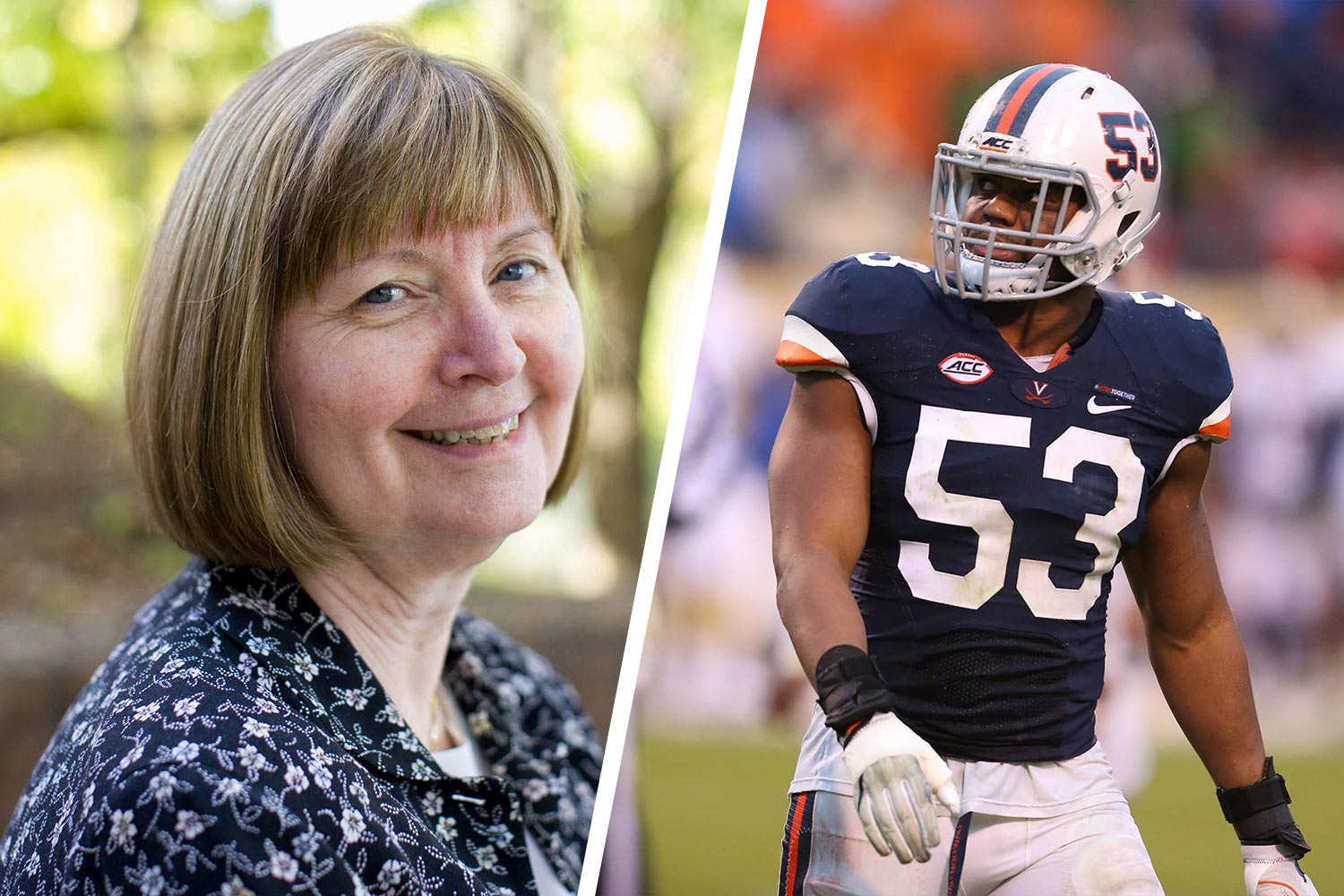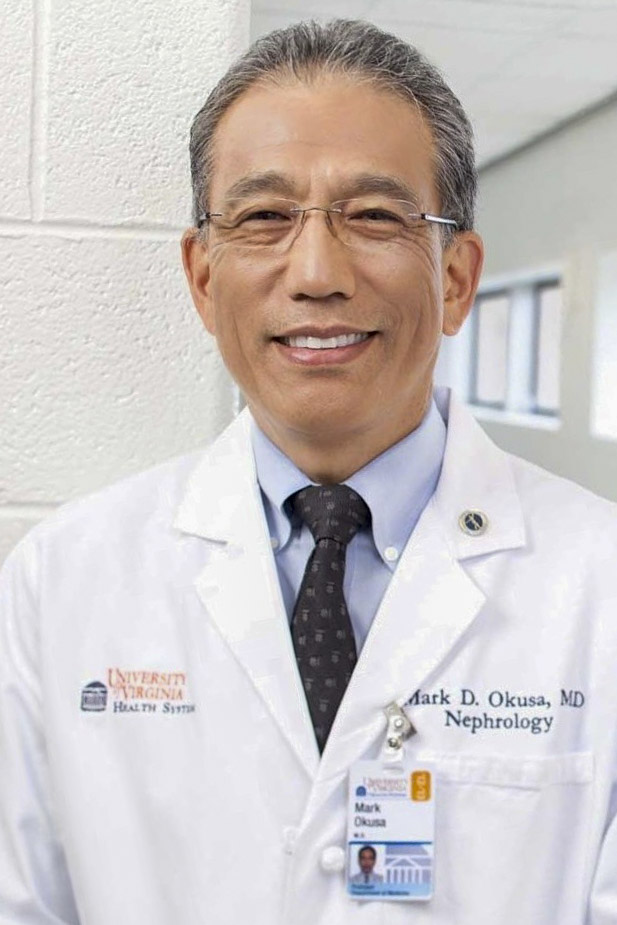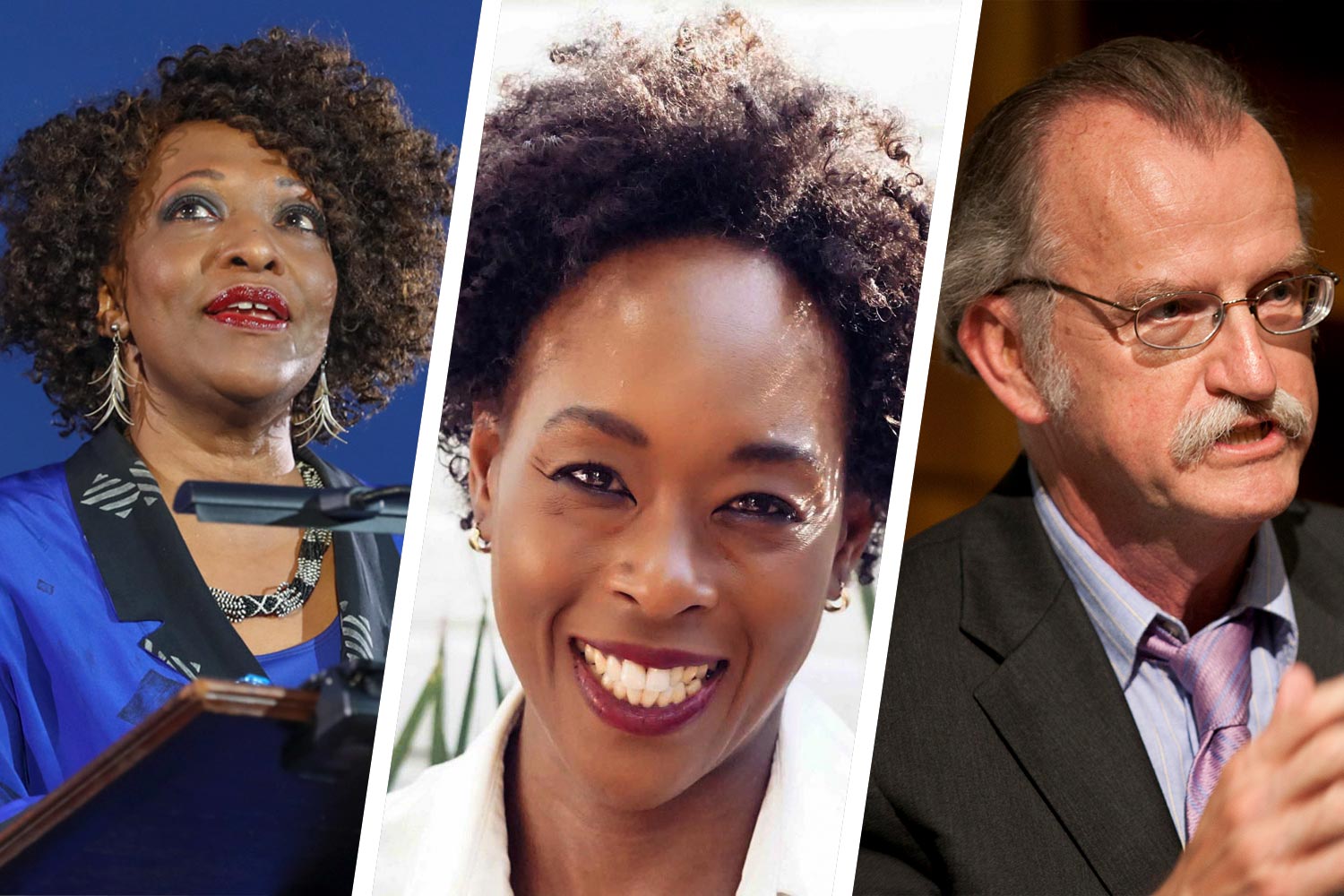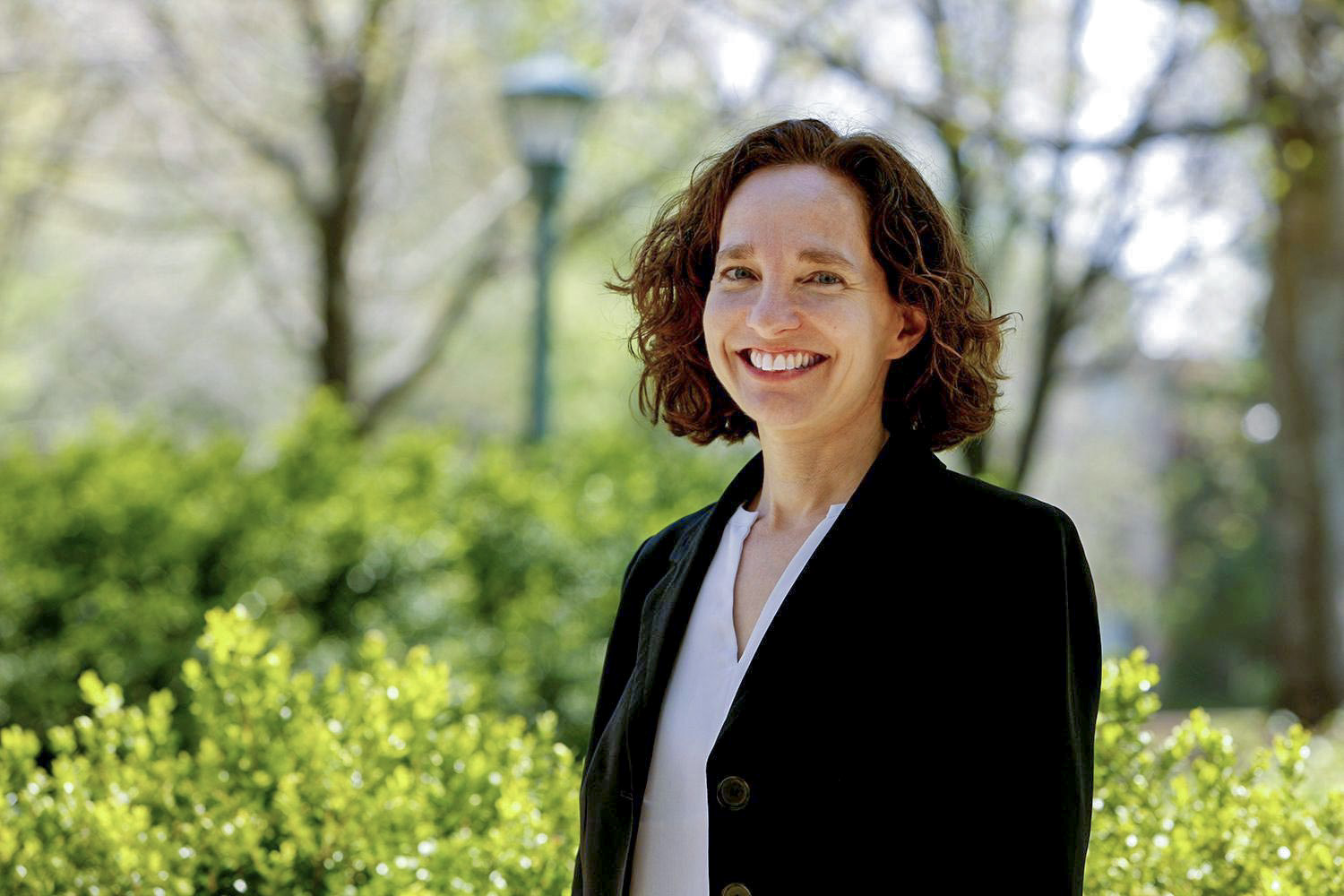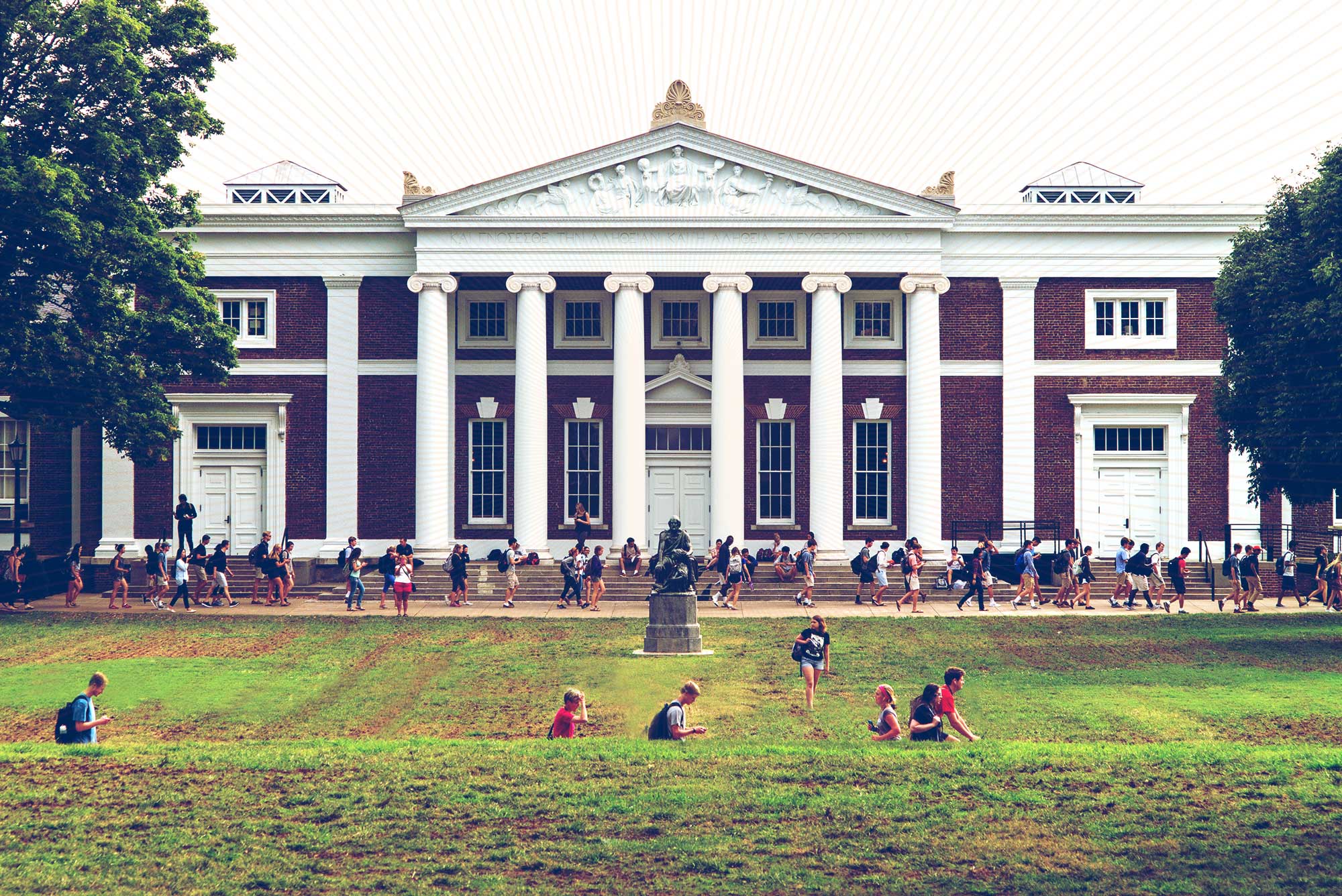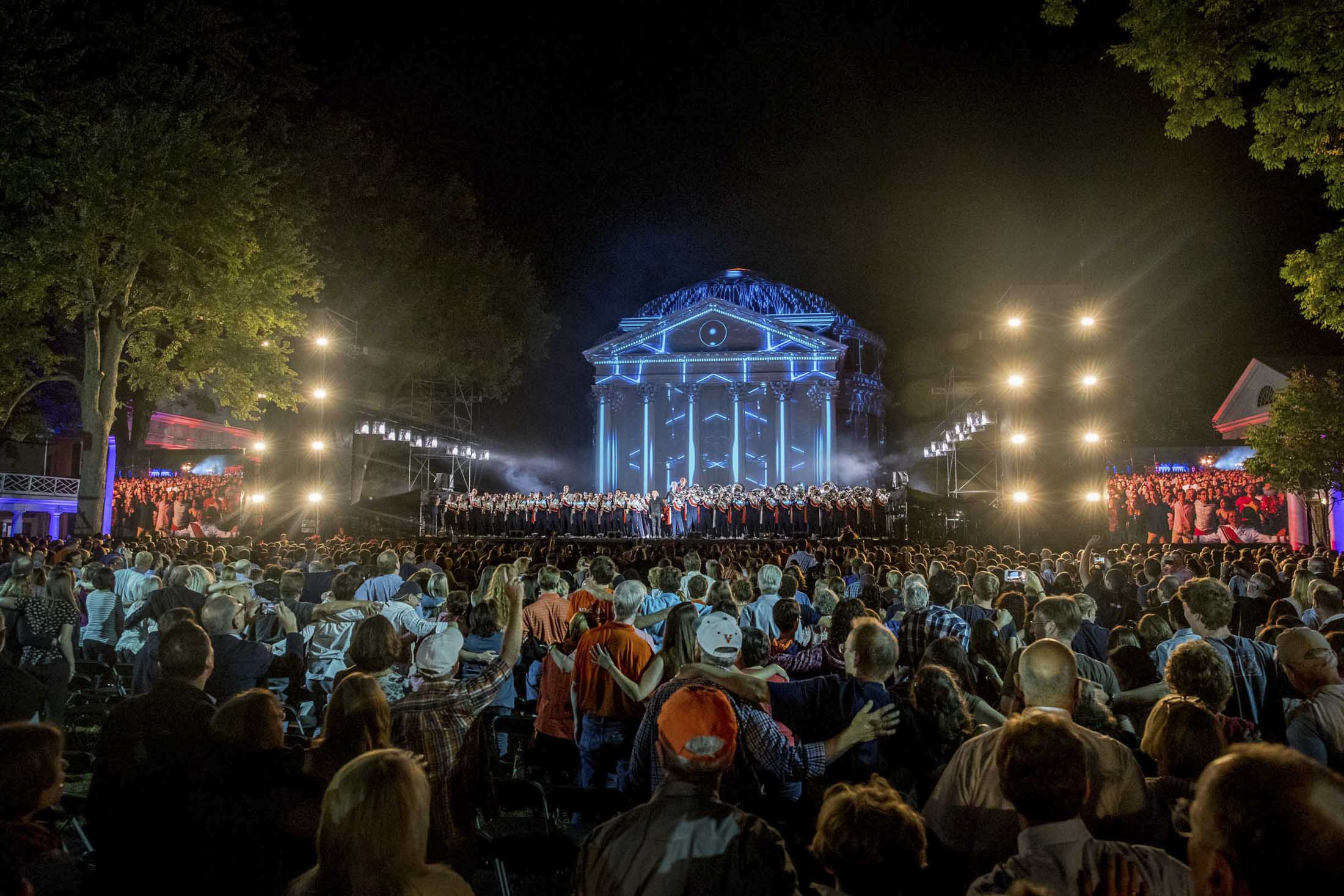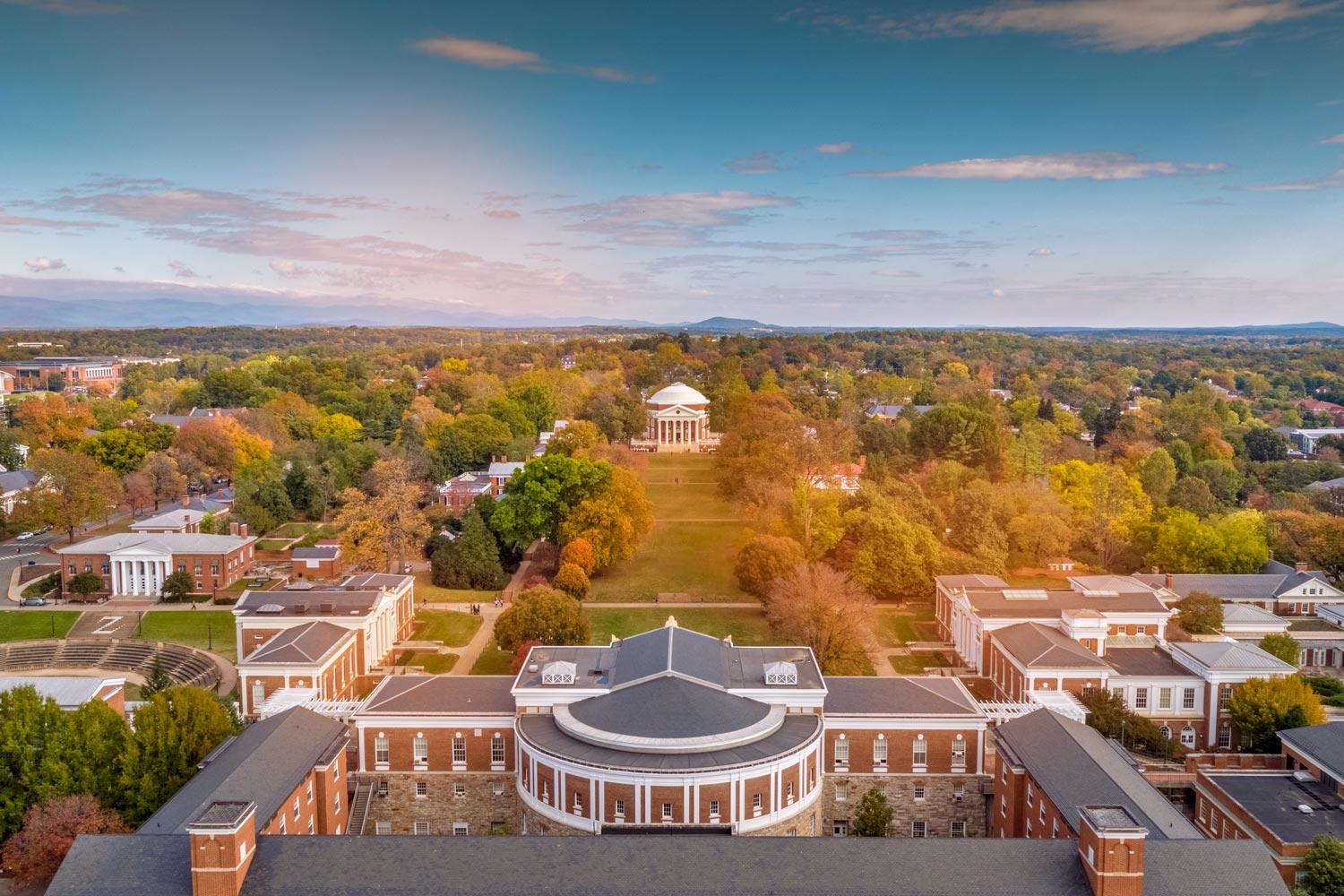
As she prepares to step down as the University of Virginia’s faculty athletics representative, Curry School of Education professor Carolyn Callahan is being recognized alongside an outstanding UVA scholar-athlete by the National Football Foundation and College Hall of Fame.
Fourth-year student Micah Kiser, an All-Atlantic Coast Conference linebacker on the Cavalier football team, is a National Football Foundation National Scholar-Athlete and one of 13 finalists for the William V. Campbell Trophy, often called “the academic Heisman Trophy.” As a finalist, he receives an $18,000 post-graduate scholarship. The winner of the Campbell Trophy, to be announced Dec. 5, will receive an additional $7,000 in scholarship funds.
Kiser graduated in May with a degree in foreign affairs, and is playing this fall as a graduate student in the Curry School’s master’s program in higher education.
As UVA’s faculty athletics representative, Callahan is recognized alongside Kiser as part of the National Football Foundation and College Hall of Fame’s “Faculty Salutes” program. Additionally, each school with a Campbell Trophy finalist receives $5,000 to support its academic support services for student-athletes.
“Honoring the faculty athletics representatives from the schools with NFF National Scholar-Athletes sends a powerful message,” said Archie Manning, the foundation’s chair. “There is no group more committed to the well-being of our student-athletes, and the NFF National Scholar-Athlete success stories provide a natural vehicle for emphasizing the important contributions of the faculty athletics representatives in ensuring a strong connection between the academic and athletic experiences of our nation’s student-athletes.”
Callahan has announced her retirement as UVA’s faculty athletics representative after 20 years in that role. Carrie M. Heilman, an associate professor of marketing in the McIntire School of Commerce, will officially take over on Jan. 1.
UVA Doctor Elected President of the American Society of Nephrology
The American Society of Nephrology has elected UVA’s Dr. Mark D. Okusa as its president for the coming year.
Okusa, John C. Buchanan Distinguished Professor of Medicine at the UVA School of Medicine and chief of nephrology at the UVA Medical Center, also directs UVA’s Center for Immunity, Inflammation, and Regenerative Medicine. Board-certified in internal medicine and nephrology, he has been in practice for more than 20 years, and has been voted as one of Castle Connolly’s Best Doctors in America each year since 2001.
Okusa’s National Institutes of Health-funded research focuses on the role of inflammation and immune cells in initiating and maintaining acute kidney injury, and his findings in preclinical studies have served as a foundation for clinical trials for both acute kidney injury and progressive kidney disease. Okusa has served, and continues to serve, on national and international panels to help develop clinical practice guidelines and set the research agenda for acute kidney injury.
“I am honored and excited about being elected president of the American Society of Nephrology for this coming year and very grateful to the membership for giving me this once-in-a-lifetime opportunity,” he said.
School of Medicine Earns National Diversity Award for Sixth Straight Year
For the sixth consecutive year, the UVA School of Medicine has received a national award for its commitment to diversity and inclusion.
UVA is one of 24 U.S. health professions schools to receive the 2017 Health Professions Higher Education Excellence in Diversity Award from INSIGHT Into Diversity magazine, a national publication covering diversity in higher education.
“Our standards are high, and we look for institutions where diversity and inclusion are woven into the work being accomplished every day across their campus,” the publication said in announcing this year’s winners.
UVA’s diversity efforts include:
- Summer Medical Leadership Program. This six-week summer academic enrichment program brings together 30 college undergraduates interested in medical careers who are from disadvantaged backgrounds and underrepresented groups in medicine. The main goal is to expose participants to the “real world of medicine” to prepare them not only for admission to medical school, but to assume future leadership positions in their chosen medical field.
- Partnerships with local schools. The School of Medicine hosts a Poster Symposium each year at Charlottesville High School to introduce high school students – and future health-care workers – to conducting medical research. As part of their projects, students visit the UVA Claude Moore Health Sciences Library and are mentored by UVA research scientists.
- Committee on Women. The committee promotes opportunities for mentoring and leadership for women throughout the School of Medicine, including an annual award honoring a faculty member for their leadership efforts.
- Latino Health Initiative. In partnership with groups across UVA and the Charlottesville area, initiative members work to improve health literacy, outcomes and access to care for local Latino residents. Ongoing projects include biweekly cardiovascular disease screening and education sessions, as well as training and empowerment for Latino community health workers.
“To receive this award six years in a row reflects the School of Medicine’s dedication and commitment to diversity and inclusion,” said Dr. David S. Wilkes, the school’s dean. “This is a great team effort. Our faculty, staff, and students consistently keep our core institutional values of respecting everyone at the forefront of what they do.”
Rita Dove, Two Alumni Among State Literary Award Winners
UVA was well-represented at the Library of Virginia’s 20th Annual Library of Virginia Literary Awards, handed out on Oct. 14.
Rita Dove received the Literary Award for Poetry for her book, “Collected Poems: 1974-2004,” which the judges described as “three decades of powerful lyric poetry from a virtuoso of the English language.”
A past Library of Virginia Lifetime Achievement Award honoree, Dove is Commonwealth Professor of English at UVA, where she has taught since 1989. She served as U.S. Poet Laureate (1993-95) and Poet Laureate of Virginia (2004-06) and has received numerous literary and academic honors, among them the 1987 Pulitzer Prize in Poetry, the 1996 Heinz Award in the Arts and Humanities, a National Humanities Medal from President Clinton, and a National Medal of Arts from President Obama.
“Collected Poems” was a 2016 National Book Awards finalist and a 2016 NAACP Image Award winner.
Among the other finalists for the poetry award was UVA English professor Lisa Russ Spaar, editor of “Monticello in Mind: Fifty Contemporary Poems on Jefferson.”
Alumna Margot Lee Shetterly won the Literary Award for Nonfiction for her New York Times best-selling book, “Hidden Figures: The American Dream and the Untold Story of the Black Women Mathematicians Who Helped Win the Space Race,” which “celebrates these unsung heroes and their experiences with issues of race, gender and scientific innovation,” according to the judges.
A 2014 Alfred P. Sloan Foundation Fellow and a Virginia Foundation for the Humanities grantee, Shetterly is the founder of the Human Computer Project, an endeavor that is recovering the names and accomplishments of all of the women who worked as computers, mathematicians, scientists and engineers for the National Advisory Committee for Aeronautics and NASA from the 1930s through the 1980s. A Hampton native, she knew many of the women behind the history in “Hidden Figures,” which was adapted into a Young Reader’s Edition, a picture book and an Oscar-nominated film.
The other finalists for the nonfiction prize included Annette Gordon-Reed and UVA history professor emeritus Peter S. Onuf for “’Most Blessed of the Patriarchs’: Thomas Jefferson and the Empire of the Imagination.”
“Hidden Figures” also won the People’s Choice Award in the nonfiction category, chosen by readers in an online vote.
Law School alumnus David Baldacci won the Library of Virginia’s Literary Lifetime Achievement Award.
He published his first novel, “Absolute Power,” in 1996; a feature film followed, with Clint Eastwood as its director and star. He has published 34 novels for adults; all have been national and international best sellers, and several have been adapted for film and television. His novels have been translated into more than 45 languages and sold in more than 80 countries; more than 110 million copies are in print worldwide. Baldacci has also published six novels for younger readers.
All of the winners received a monetary prize and an engraved crystal book.
Virginia Commission for the Arts Also Honors Dove
Rita Dove, Commonwealth Professor of English and former U.S. Poet Laureate, has been named as one of 10 “Outstanding Artists” by the Virginia Commission for the Arts, as part of its “50 for 50 Arts Inspiration Award” program.
The honorees – 10 apiece from each of five categories – were selected from a pool of more than 350 nominees by a panel of former commissioners and arts leaders and confirmed by the full board of the Virginia Commission for the Arts.
The “50 for 50 Arts Inspiration Awards” are designed to recognize “programs, individuals and organizations critical to the arts in Virginia,” according to the announcement.
“We are indeed fortunate in Virginia to have an abundant and diverse roster of outstanding artists and organizations and their supporters spanning disciplines and decades,” the commission said in its announcement.
The winners will be officially recognized Jan. 31 at the commission’s 50th Anniversary Program for arts organizations across the state at the Virginia Museum of Fine Arts in Richmond.
UVA Nurse a Finalist for National Compassionate Caregiver of the Year
UVA palliative care nurse Jonathan Bartels was one of six finalists for the 2017 National Compassionate Caregiver of the Year Award, given by the Schwartz Center for Compassionate Healthcare in Boston. The award honors “outstanding health care professionals who display extraordinary devotion and compassion in caring for patients and families. The award recognizes those who make a profound difference through their unmatched dedication to compassionate, collaborative care.”
Bartels developed “The Pause,” which provides caregivers and family members with a moment for silent reflection after the death of a patient. In its profile of Bartels, the Schwartz Center described The Pause as “a means of transitioning and demarcating the brevity and importance of this moment. The Pause is a means of honoring a person’s last rite of passage and an opportunity for health care professionals to come together amidst suffering and loss.”
The profile continued, “As one colleague writes, ‘[Bartels] is a listener, inspirational leader of fierce compassion, and making an impact with one unique intervention among many, to ease suffering for families and health care providers.’”
Bartels talked about how he initiated The Pause in a first-person story for the Virginia Magazine. He was recognized as a finalist Nov. 16 at a ceremony in Boston.
Law Dean Wins Legal History Book Award for ‘Vagrant Nation’
School of Law Dean Risa Goluboff has won the American Society for Legal History’s John Phillip Reid Book Award for “Vagrant Nation: Police Power, Constitutional Change, and the Making of the 1960s.”
The award is the fourth major honor for the book, published in 2016 by Oxford University Press. The society considers both senior and mid-career scholars for the award.
“I am thrilled that my fellow legal historians find the book deserving of this honor,” Goluboff said.
The book, her second, has also received this year’s Littleton-Griswold Prize, Lillian Smith Book Award and David J. Langum Sr. Prize in American Legal History.
“Vagrant Nation” explores how and why vagrancy laws that had been on the books for hundreds of years rapidly collapsed in the span of two decades.
Goluboff is an expert in constitutional law and legal history whose first book, “The Lost Promise of Civil Rights,” won the 2010 Order of the Coif Biennial Book Award and the 2008 James Willard Hurst Prize.
National ‘100 Great Heart Programs’ List Features UVA
Becker’s Hospital Review has named the Heart and Vascular Center at UVA Medical Center to the national health care publication’s 2017 list of 100 hospitals and health systems with great heart programs.
“The hospitals named on this list are national leaders in cardiovascular health care,” according to Becker’s. “Many institutions pioneered groundbreaking procedures and remain on the forefront of heart care today. All have received recognition for delivering top-notch patient care.”
Becker’s highlighted the more than 300 heart transplants that have been performed at UVA, as well as UVA being ranked 50th nationally for cardiology and heart surgery in the most recent rankings from U.S. News & World Report.
UVA Heart and Vascular Center leaders said the award highlights their efforts to provide high-quality, comprehensive heart care.
“We are excited to see our multidisciplinary team recognized for their collaborative efforts to provide the best care for patients throughout Virginia,” said Dr. Brian H. Annex, chief of the Division of Cardiovascular Medicine and medical director of the UVA Heart and Vascular Service Line.
“The award from Becker’s Hospital Review reflects our efforts to serve patients with a wide range of heart and vascular conditions,” added Dr. John Kern, chief of the Division of Cardiac Surgery and surgical director of the UVA Heart and Vascular Service Line.
UVA Health System Pharmacy Administrator Honored for Leadership, Service
The Virginia Society of Health-System Pharmacists has given Rafael Saenz, the UVA Health System’s pharmacy administrator, its R. David Anderson Distinguished Leadership Award.
Saenz was recognized in November both for his enhancements to pharmacy services at UVA and his service at both the state and national levels to enhance pharmacy services.
Saenz’s efforts have included doubling the size of UVA’s retail pharmacy services, including the Charlottesville area’s only outpatient pharmacy that is open 24 hours a day, seven days a week; introducing specialty pharmacy services; and expanding UVA’s pharmacy residency programs.
Saenz has also been active with state and national pharmacy groups. He created the Virginia Society of Health-System Pharmacists’ Commonwealth Leadership Forum to bring together pharmacy directors from across Virginia to discuss common issues. He has also worked to create national consensus around a singular pharmacy technician training standard and participated on a national committee to rewrite technician training standards, while also representing hospital and health system pharmacies on the Virginia Board of Pharmacy.
To help expand the supply of pharmacists and pharmacy technicians, Saenz chaired the American Society of Health-System Pharmacists’ Council on Education and Workforce Development. He also worked locally with Piedmont Virginia Community College to create accredited pharmacy technician training programs and with Virginia Commonwealth University to bring more pharmacists to Central Virginia.
Local Food Hub Honors Health System
Local Food Hub has named the UVA Health System as a “Healthy Community Leader” at its annual Community Food Awards event, held Oct. 19.
The Healthy Community Leader award recognizes a community organization that demonstrates a commitment to partnering with Local Food Hub on increasing education about, and access to, local food.
The Health System, including the UVA Medical Center, BeWell and Morrison Healthcare, piloted a workplace wellness program with Local Food Hub to increase access to fresh, healthy foods among Health System employees.
“The Community Food Awards is a special opportunity to celebrate the farmers, businesses and nonprofit organizations that are helping to make healthy, local food available to all,” said Kristen Suokko, executive director of Local Food Hub. “We are honored to partner with these award winners.”
Engineering Professor Earns Honorary Doctorate from University of Waterloo
Yacov Haimes, Lawrence R. Quarles Professor of Systems and Information Engineering and founding director of UVA’s Center for Risk Management of Engineering Systems, on Oct. 21 received an honorary doctorate from the University of Waterloo in Waterloo, Ontario.
“He is globally renowned for his research in systems engineering, and leads the field in applying interdisciplinary, systems and multi-objective decision making perspectives to risk assessment,” the school said in announcing the award. “His techniques have helped address complex challenges in several domains, including water resource management and environmental engineering.”
The degree is the highest granted by the University of Waterloo.
Haimes earned a B.S. from Hebrew University in Jerusalem, and master’s and doctoral degrees from the University of California, Los Angeles. He has written or co-written six books and 300 technical publications, more than 200 of which were published in archival-refereed journals. He has served as dissertation/thesis adviser to 39 Ph.D. students, 85 M.S. students and 132 B.S. students.
